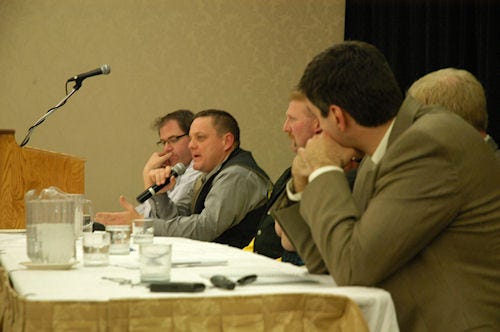February 13, 2012

Nobody threw tomatoes at the National Corn Growers Association economist who spoke at the recent I-29 Corridor Dairy Conference in Sioux Falls.
But when Nathan Fields took the podium he said he was worried he might have to dodge some tomatoes.
That's because milk producers have been squeezed by high corn prices and there was talk at the conference of corn prices going even higher.
Martin Bozic, University of Minnesota, assistant professor, dairy foods marketing, said that corn could go to $10 per bushel this summer if there were a drought in the Cornbelt or if there were air strikes against Iran.

Dan Rice, manager of Prairieland Dairy, describes how they are coping with high feed costs during a panel discussion at the I-29 Corridor Dairy Conference.
And, a presentation by Paul Caspers, South Dakota State University dairy science professor, was titled, "How are we going to feed cows in the future? Using $10 corn and $200 oil."
Fields, NCGA economist, agreed that it was possible corn prices could rise this summer. But in the long-term, prices might "level off in the mid-$4 range" as corn supplies grow, he said.
"There's no cure to high corn prices like high corn prices," he said.
If corn prices get too high, dairy producers need to start using more "rocket fuel" forage and cuting back on corn, Casper said.
"Rocket fuel" forages are those forages with extremely high digestibility.
"It's possible to consistently obtain forage that's 76-80% digestible," he said.
"Rocket fuel" forage will cost more than lower quality forage, but corn and supplements in the region can—and should be – cut back, he said.
"Not cutting back is the biggest mistake people make when using high quality forage."
A couple dairy producers participating in panel discussion described how they were planning to cope with high corn costs.
Les Hardesty, Painted Prairie Farm, Weld County, Colo., said he plans to double the amount of land he owns and rents so he can grow more of his own corn and alfalfa.
"It's a paradigm shift for western dairies," he said. "We're investing in farmland instead of expanding."
Dan Rice, manager of Prairie Land Dairy, Firth, Neb., said he doesn't plan to try and buy land. He can't compete with crop farmers for land. They have had several good years and he's hasn't. Instead, Rice hopes to work more closely with farmers who currently produce feed for the dairy to increase the quality and consistency of the forages they deliver. He'd also like to establish some longer-term contracts that work for both parties.
Rice also is looking to generate others sources of revenue from the dairy. They bottle and sell some of their milk to grocers in nearby Lincoln and other cities. They also sell meat and compost direct to customers. He's even sold milk to an organic farmer who has used it as fertilizer.
"Look at what corn growers did when their product was $2 (per bushel)," he said. "They went out a created a new market – ethanol. We need to do that, too. We have to start thinking larger."
You May Also Like




